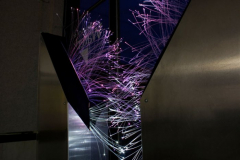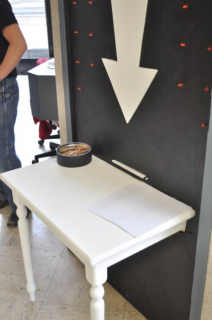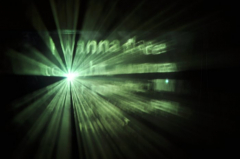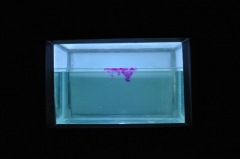#kwtweetme
Mike Kwan, Gary Carlson, Jason Dyck, and Kristina Foster
Fiber optics, brushed aluminum sheets,Plexiglas, wood, black cloth, RGB LEDs, white LEDs,wiring, power supply, laptop.
Description:
Involving investigation at both a microscopic and macroscopic perspective throughtechnological and metaphorical methods; communication, community, and conversion arefundamental concerns of this work. Cross-modal transitions that take place within the twoforms and the poetic nature of the conversation addresses these variable concerns. Onlylimited interaction can happen within the gallery space, so an outside source is utilized toincorporate the general community within range of the work. This remote connection linksa single dialogue to a wide range of systems that promote conversation and interactivitywithin a society; reinforcing translations and differentiations within transmission of sensations,sentiments, and statements in the form of digital information.
The singular tête-à-tête also translates graphemes into a completely different mode; a furthertranslation of expression into colour. A subjective synesthetic1 map derives the transition ofwords; where a synesthete perceives a specific letter that invokes a specific colour wheneverthis particular individual perceives said letter. The system is embedded within a digitalvernacular, again reinforcing the main point; communication. Also, the material is chosento reflect back on the viewer: not only to incorporate them into the ongoing dialogue beforethem, but allows the viewer to realize that they are a part of the unending digital collective.
Using an existing source, a live Twitter feed spanning a 50 kilometer radius which includesthe KW area, raw data processes into two streams which then relate every grapheme in thestream to a coded colour relating to that exact grapheme. The result is a constant stream ofcolour which fades off into the neutral white that is the culmination of RGB colour.
________________________________________________________________________________________
Power Trip
Shayan Alivandi-Fars, Kristen Antaya , Konrad Mohring, Adam Yim
Things used to create Power Trip include: wood, paint,an Arduino Microcontroller, various sensors, motors, wires,and doodads, blood, sweat, and tears
Description:
Who created this? This deceptively simple question was the genesis of Power Trip, a piece thatchallenges its audience to examine the ideas of ownership and authorship through interactionwith the work itself.
Through a Faustian exchange, Power Trip asserts its ownership of artwork submitted by theaudience; however, it is unclear whether this assertion is an act of appropriation or one of creation.
Audience involvement is essential to Power Trip, and so striking a playfully sincere tonewith this piece was important to the artists. They felt this balance was necessary in order toencourage both interaction with and critical analysis of the work. This interaction allows PowerTrip to directly engage its audience and confront them with the question: Who created this?
________________________________________________________________________________________
I Wish I Had Never Said
Tong (Raine) Shen, Darius Gai, Curtis Knischewsky, Adam Frank, Rebecca Ho
Fog machine, fridge-turned-cooling system, swing-set supports, pipes, honeycomb air vent, air blower, computers, website, proximity sensors, projector, arduino
Description:
To build an environment where secrets can be shared anonymously, and transforming the memory behind the secrets into a public sensation.
Our work is partially inspired by websites such as Postsecret and fml.com, where people submit private information for the public to see, judge, and reflect on. The idea that one can use technology to pardon their actions by means of an unknown confessor was intriguing to us. We chose to ask the public to complete the sentence “I wish I never said _____”, and project the response onto a hand-made fog screen.
By doing so we ask participants to reflect on their past, and reflect on what they regret saying the most. Memories of the past are much like the effects of fog: often cloudy, distorted and slowly deteriorating. The room containing the fog screen becomes a sacred place and the fog becomes the medium by which these regrets, memories and uncensored messages are given validation. The machine is programmed to give finality to the things people wish they had never said by shutting off and letting the fog float away.
________________________________________________________________________________________
Think Tank
Tomasz Ciochon, Nakita Martin Russillo, Jennifer Won, and Christ Korroch
Tech materials: laptop, speakers, motion detector sensor,microcontroller, servo motors (2), sconce lights, phenolphthalein,ammonia, vinegar, magnetic mixer
Construction materials: fish tank, book shelf,squeeze bottles (2), plexi-glass
Description:
This is a communication piece: the swirl of colour you see represents an idea taking shape andthe subsequent soundtrack and disappearing act represents the idea succumbing to analysisand (constructive) criticism. The concept was formed and motivated by this group’s experiencebrainstorming ideas for this very project. The cycle of appearing and disappearing representsour struggle and the challenge that this project presented to us. The colour is created by achemical reaction of a pH indicator, phenolphthalein. Its chaotic nature perfectly reflects thechaotic nature of illusive concepts and ideas being born. As well, the chemical reaction wasselected as a visually appealing medium by which we could express our concept.
Click on images to enlarge and click again to close.
Return to the projects page.





















